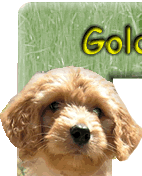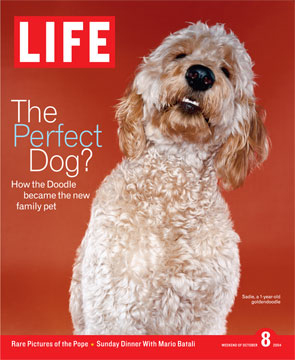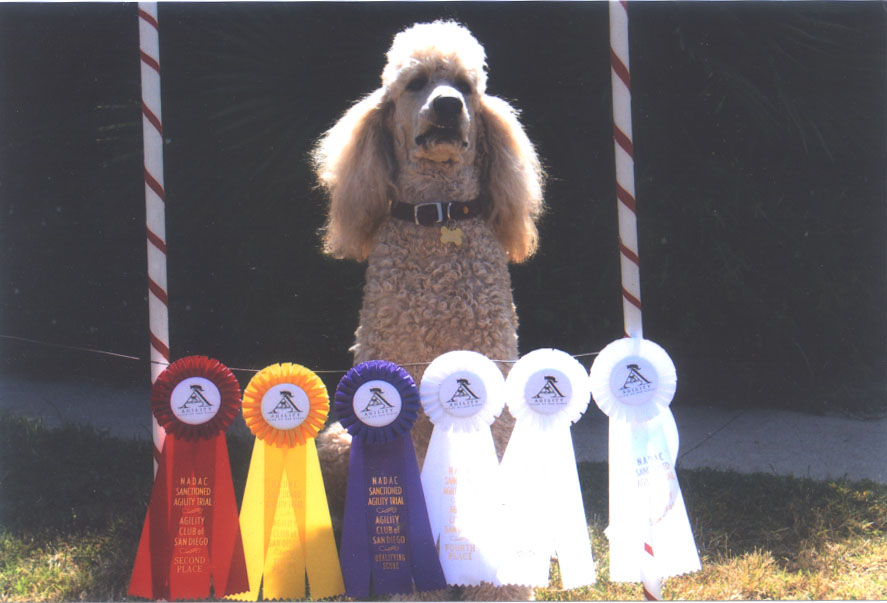


Frequently Asked Questions
Welcome to our Frequently Asked Questions section. Here you will find answers to most of the questions you may have, please look through the list and feel free to contact us if you still have other questions.
Buck's father with some of his awards |
Aries, Buck's father |
What is the Origin of a Goldendoodle?
A Goldendoodle is a Golden Retriever and Poodle cross. Goldendoodles, also called Doodles, Golden Poos, Goldie Poos, or Groodles, have been bred in North America and Australia since the mid-1990's. As the smaller poodle hybrids had been such a success in filling the niche for small, allergy friendly family pets, Golden Retriever breeders decided to try a breeding with a standard poodle for a larger family pet. This led to Medium and Miniature sizes which have become extremely popular as well with those that wanted a smaller companion that had just as much a fun, active and loving personality as their larger cousins. The quick rise of Goldendoodles is due to the dogs themselves. They are a most marvelous hybrid.
Why breed Golden Retrievers to Poodles?
The designer blending of two superior companion breeds make an exceptional family pet, the loyalty and ease of training Goldendoodles make an extraordinary family canine companion. Hybrid Vigor allows for superior pet with excellent health. The hypo-allergenic attribute of the poodle is another positive characteristic!
What is Heterosis or Hybrid Vigor?
Heterosis is a term used in genetics and selective breeding. The term heterosis, also known as hybrid vigor or outbreeding enhancement, describes the increased strength of different characteristics in hybrids; the possibility to obtain a genetically superior individual by combining the virtues of its parents.
Heterosis is the opposite of inbreeding depression, which occurs with increasing homozygosity. The term often causes controversy, particularly in terms of the selective breeding of domestic animals, because it is sometimes believed that all crossbred plants or animals are genetically superior to their parents; this is true only in certain circumstances : when a hybrid is seen to be superior to its parents, this is known as hybrid vigor.
How
old are the puppies before they are sold?
California State Law, most Veterinarians and common sense agree all puppies must be eight weeks old before they may go home with their new families, however most are actually sold before that with a deposit and go home after their 8th week. So it is best to contact us and leave a deposit if you are interested in having first choice.
Are
the puppies given their shots?
All
of our puppies are given their shots up to the point you receive them, however there
will still be follow up shots that are provided by your local Veterinarian.
When can I see my puppy?
We welcome prospective buyers of quality Goldendoodles at our own home. If you are interested in obtaining one or more of our adorable puppies we can arrange an appointment. Our responsibility as a breeder is to provide quality, healthy, registered pure goldendoodles and happy canine companions we take every precaution possible to ensure this happens. We guard against contamination by irresponsible people.
What is your health guarantee?
We have a 15 day guarantee, take the puppy to any veterinarian and if for ANY reason he feels the puppy is a poor health risk please return it for a full refund. We also guarantee the dog for one year against hip dysplasia or any other debilitating congenital disorder. Please see the notice of rights below:
§ 122100. Written notice of rights; provision to and signature of purchaser; form; contents
Every breeder that sells a dog shall provide the purchaser at the time of sale, and a prospective purchaser upon request, with a written notice of rights, setting forth the rights provided for under this section. The notice shall be contained in a separate document. The written notice of rights shall be in 10- point type. A copy of the written notice of rights shall be signed by the purchaser acknowledging that he or she has reviewed the notice. The notice shall state the following:
"A STATEMENT OF CALIFORNIA LAW GOVERNING THE SALE OF DOGS
The sale of dogs is subject to consumer protection regulation. In the event that a California licensed veterinarian states in writing that your dog is unfit for purchase because it became ill due to an illness or disease that existed within 15 days following delivery to you, or within one year in the case of congenital or hereditary condition, you may choose one of the following:
(1) Return your dog and receive a refund of the purchase price, plus sales tax, and receive reimbursement for reasonable veterinarian fees up to the cost of the dog, plus sales tax.
(2) Return your dog and receive a dog of your choice of equivalent value, providing a replacement dog is available, and receive reimbursement for reasonable veterinarian fees up to the cost of the dog, plus sales tax.
(3) Keep the dog and receive reimbursement for reasonable veterinarian fees up to 150 percent of the original purchase price of the dog plus sales tax on the original purchase price of the dog.
In the event your dog dies, you may receive a refund for the purchase price of the dog, plus sales tax, or a replacement dog of your choice, of equivalent value, and reimbursement for reasonable veterinary fees for the diagnosis and treatment of the dog, if a veterinarian, licensed in this state, states in writing that the dog has died due to an illness or disease that existed within 15 days after the purchaser obtained physical possession of the dog after the sale by a dog breeder, or states that the dog has died due to a congenital or hereditary condition that was diagnosed by the veterinarian within one year after the purchaser obtained physical possession of the dog after the sale by a dog breeder. These fees may not exceed the purchase price of the dog, plus sales tax.
In order to exercise these rights, you must notify the dog breeder as quickly as possible but no later than five days after learning from your veterinarian that a problem exists. You must tell the dog breeder about the problem and give the dog breeder the name and telephone number of the veterinarian providing the diagnosis.
If you are making a claim, you must also present to the dog breeder a written veterinary statement, in a form prescribed by law, that the animal is unfit for purchase and an itemized statement of all veterinary fees related to the claim. This information must be presented to the dog breeder no later than five days after you have received the written statement from the veterinarian.
In the event that the dog breeder wishes to contest the statement or the veterinarian's bill, the dog breeder may request that you produce the dog for examination by a licensed veterinarian of the dog breeder's choice. The dog breeder shall pay the cost of this examination.
In the event of death, the deceased dog need not be returned to the dog breeder if you submit a statement issued by a licensed veterinarian stating the cause of death.
If the parties cannot resolve the claim within 10 business days following receipt of the veterinarian statement or the examination by the dog breeder's veterinarian, whichever event occurs later, you may file an action in a court of competent jurisdiction to resolve the dispute. If a party acts in bad faith, the other party may collect reasonable attorney's fees. If the dog breeder does not contest the matter, the dog breeder must make the refund or reimbursement no later than 10 business days after receiving the veterinary certification.
This statement is a summary of key provisions of the consumer remedies available. California law also provides safeguards to protect dog breeders from abuse. If you have questions, obtain a copy of the complete relevant statutes.
This notice shall be contained in a separate document. The written notice shall be in 10-point type. The notice shall be signed by the purchaser acknowledging that he or she has reviewed the notice. The dog breeder shall permit persons to review the written notice upon request.
NOTE: This disclosure of rights is a summary of California law. The actual statutes are contained in Article 1 (commencing with Section 122045) of Chapter 5 of Part 6 of Division 105 of the Health and Safety Code."
CREDIT(S)
(Added by Stats.1995, c. 415 (S.B.1360), § 7.)
For more information on California pet sales and rights please click here.
What else should I ask?
Every other question you may have requires you to think "Does this make sense to me?". Google Search can lead you to advice that can be informative or confusing or just plain foolish. Everywhere you look someone has an opinion and advice; some great and some not so much. For example we are often asked our stance on 'BARF' Diets (Biologically Appropriate Raw Food) as they are often touted as more evolutionary based and promote a variety of health benefits from shinier coats to smaller stools. As you may know the domesticated dog has been a companion of people for hundreds of generations. We believe the health risks associated with "Raw Food Diets" far outway any potential benefits. Any such foods MUST be supplemented to complete a dogs healthy diet, and the threat to the health of the owner, family and the dog itself from harmful bacteria is always present in uncooked or undercooked meats. We feel you should feed your new companion, Puppy Food that the puppy has had all his or her life. You may decide to change brands and that is up to your discretion, we however strongly recommend you wait until after your puppy finishes potty training.
Are Goldendoodles Hypo-Allergenic?
This breed produces almost no dander which makes them virtually hypo-allergenic.
Do Goldendoodles Shed?
Yes. Anyone who states they do not shed is fibbing. ALL mammals, people, dogs, cats etc shed to some degree. Goldendoodles as a breed are among those that shed the least however.
Do Goldendoodles have Hair or Fur?
Hair and fur are made of keratin and have the same chemical composition as skin, feathers and nails. They are the same thing and are often merely used to describe traits or texture differences between breeds.
ADDITIONAL ADVICE:
- Choose a good veterinarian, one you feel comfortable with and trust as soon as you can. Research the Vets you are looking at and read reviews.
- Call or email us if you have any questions.
- USE COMMON SENSE. If something sounds like it would be bad it probably is.
Training
Routine: In every aspect of your puppies early life try to keep it on a consistant schedule.
Positive Reinforcement: Reward good behavior or successful training, don't scold or punish your puppy for accidents.
NEVER use your puppies name negatively ie: "BAD ROSIE" if you must scold the puppy just use words like "No" "Bad" etc.
Patience: It can be frustrating at times and accidents happen. All things will work out in time try to stay calm and stick to what you know. If you need help we are just a call away.
Our puppies grow up in whelping rooms. These are climate controlled safe enviroments with a doggy door leading to a run. For the first four weeks the puppies are on only mothers milk and the mother cleans up after the puppies and keeps the interior room extremely clean. At 4 weeks we begin to supplement their diet with puppy food. Now their waste no long smells like mom and she starts to push them outside. We also condense the interior to be only big enough for mom and pups to dog pile together. Within a few days all the puppies have learned to go out the doggy door and only do their business outside in the run.
Crate Training ?
We strongly recommend crate training, it dramatically increases the speed and success in feeding and potty training. If you plan on leaving the crate available to your dog when it reaches full size choose one that will fit his adult size and use a divider. You want to crate to be big enough for him to be able to turn and lay down comfortably but not large enough he can lay in one corner and defecate in the other. The crate should be placed in a quiet dark area with little to no 'traffic'.
Feeding?
Our puppies are free fed until the day you pick them up. This is great for happy healthy puppies but you can't continue this if you want to potty train. When you bring your puppy home we strongly recommend getting the puppy on a morning, after and evening feeding schedule. You want to leave the food down with the puppy for no longer than 10 minutes. At first the puppy may not eat much since he had been used to eating whenever he wanted but he will get the idea pretty fast.
Potty training?
Now the first thing you need to do when you wake up in the morning is immediatly get the puppy and take him to his potty area. Carry him all the way out, they wont potty on you while you are carrying them. This isn't time to play with the puppy or try leash training. If you put the puppy down he will follow you for about 5 feet and decide its a good enough spot. Take him to the same spot every time, and if possible don't clean the soiled area the first few times so he gets the idea of why hes there. Within 10-30 minutes of eating the puppy will need to defecate and you need to take him out again. Take away water about an hour before you put the dog to bed and take it out one last time about 10 minutes before. The dog will be fine though the night, unless someone wakes him up, in that case he might need to go out again if he doesn't immediatly return to sleep.
Tug of War / Tug Toys?
Tug toys can very easily teach bad behavior. It can be a fun and rewarding style of play but you have to have strict rules. Choose a toy thats soft and durable and make that toy THE tug toy. Fetch toys and play toys shouldn't be for Tug play. If he lunges and makes skin contact always end the play session. You want him to learn some control, it's an agressive style of play and puppies can easily get carried away.
Biting / Mouthing?
Lowering the intensity of the bites is generally my first step in training. When puppies are in group play you will often hear one suddenly yelp from a sharp bite and move away from his playmate. He will stay away for 10-15 seconds and then go back and resume play. This teaches the agressor that if they bite too hard the other puppy won't play with them.
What you need to do is something similar with your puppy. When you are playing and he bites you too hard, pull away and let out your best loud yelp or shout "Ow!" or whatever word or noise you prefer. Stop whatever activity you were doing with the puppy for at least 15 seconds. Then resume play until he does it again. Praise licking and soft mouthing behavior as well. If this isn't working at first or he's biting too much in a row, after your last 'yelp' put him in time-out for a few minutes.
The next step is to replace your hand for a toy and/or treat as the target of his mouthing. Normally the biting comes with play or petting, if that starts imediatly give him a chew toy or treat to focus on instead. This will help him get used to being touched without mouthing you. It's important to wait to do this step until you've controlled how strong he bites, because accidental slips may happen later on and you want him to have learned to do that softly.
Try to focus on activities where you aren't touching the puppy with your hands like fetch and going for walks.
There are also deterrent products like Bitter Apple you can try. They can generally be applied to skin or fabrics but keep in mind they work with some dogs and not with others.
Any other questions? Call or email us!
| Email: | goldendoodlesd@aol.com |
| Phone: | Devon (619) 988-1388 |
| Mail: |
|

Life Magazine declares the Goldendoodle the “Perfect Dog”!
